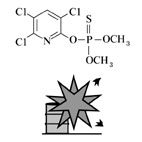| Case Name |
Explosion caused due to local heating of a drum can including insecticide (chlorpyrifosmethyl) |
| Pictograph |

|
| Date |
October 24, 1984 |
| Place |
Osaka, Osaka, Japan |
| Location |
Laboratory |
| Overview |
On October 24th, 1984, in Osaka, raw material for pesticide production (chlorpyrifosmethyl) in a drum was heated with a set of three band heaters at 70 °C to melt the material. The heater temperature rose above the set temperature locally, causing a runaway reaction of the material. After 33 hours of heating, the drum exploded. The contents blew out from the top of the building and were diffused by wind (1 m/sec). |
| Incident |
Raw material for manufacturing pesticide exploded following a runaway reaction caused by a hot spot phenomenon resulting from uneven heating. |
| Processing |
Research and development |
| Substance |
Chlorpyrifosmethyl, Fig2 |
| Type of Accident |
Explosion, leakage |
| Sequence |
Raw material for pesticide production (chlorpyrifosmethyl) in a drum can was heated with a set of three band heaters at 70 °C to melt the material contained. After 33 hours of heating, the drum can exploded. The contents blew out from the top of the building and were diffused by wind (1 m/sec). |
| Cause |
Chlorpyrifosmethyl decomposes above 130 °C. The band heater on the drum can locally exceeded the set temperature, and produced hotspots where chlorpyrifosmethyl thermally decomposed and exploded. |
| Countermeasures |
Use of appropriate heating methods. |
| Knowledge Comment |
1. With a heating method that is likely to result in uneven heating, the hazard of explosion is high for chemical materials that decompose at a relatively low temperature.
2. Use of an oil bath is recommended for equal heating. |
| Background |
1. It is difficult to heat a solid material of a certain size equally. An even heating might be possible if a liquid that was generated by heating starts convection. In addition, a band heater is likely to cause local overheating unless heat transfer to the liquid is efficient. In a word, the band-heaters were used without knowledge of the basics of heat transfer or due to their convenience.
2. Uneven heating produced hot spots on the drum can, then a runaway reaction occurred.
3. It is possible that the operators did not know that chlorpyrifosmethyl decomposes above 130 °C. |
| Reason for Adding to DB |
Example of explosion caused due to local heating of a drum can to melt the contents |
| Scenario |
| Primary Scenario
|
Ignorance, Insufficient Knowledge, There is no study about explosion dangerous temperature, Insufficient Analysis or Research, Insufficient Practice, Inclination of Heating, Usage, Operation/Use, Not Uniform Heating, Bad Event, Chemical Phenomenon, Abnormal Reaction, Secondary Damage, External Damage, Explosion
|
|
| Sources |
Osaka City fire fighting station. Other facilities. Examples of chemical disasters. (1984 February-1986 December) p.119(1987).
Masamitsu Tamura. Masahide Wakakura. Insecticide explosion (chloropirifos,ethyl) Reaction danger - Accident case and analysis - p.158(1995).
|
| Physical Damage |
Damage to a drum can, temperature sensor, etc. |
| Consequences |
Chloropyrifosmethyl spouted from the top of the building, and spread throughout nearby area. |
| Multimedia Files |
Fig2.Chemical formula
|
| Field |
Chemicals and Plants
|
| Author |
YOSHINAGA, Jun (Graduate School of New Frontier Sciences, The University of Tokyo)
TAMURA, Masamitsu (Center for Risk Management and Safety Sciences, Yokohama National University)
|